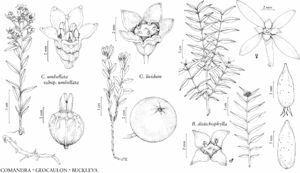Geocaulon
Rhodora 30: 23. 1928.
| Taxon | Illustrator ⠉ | |
|---|---|---|
 | Buckleya distichophylla Geocaulon lividum Comandra umbellata subsp. umbellata | Yevonn Wilson-Ramsey Yevonn Wilson-Ramsey Yevonn Wilson-Ramsey |
Herbs, perennial, andromonoecious. Rhizomes not woody, reddish to dark-brown, cortex smooth, not exfoliating. Leaves: petiole short. Inflorescences axillary (appearing terminal in early developmental stages but occupying middle axils with continued growth of main axis), cymules; cymules mostly 3-flowered; prophyllar bracteole subtending each flower caducous. Pedicels present. Flowers bisexual and staminate (central flower, or rarely 2 flowers, of dichasium usually bisexual, sometimes staminate, laterals staminate), campanulate to turbinate; hypanthium completely adnate to ovary; petals (4–) 5, greenish to bronze (bisexual and unisexual flowers often differing in color), triangular or ovate; nectary nearly flat, lobes prominent, alternating with filaments; styles short-conic; stigmas slightly lobed. Pseudodrupes usually solitary; petal remains vestigial at apex; exocarp fleshy.
Discussion
Species 1.
Geocaulon is one of only two genera named by M. L. Fernald (the other being Alcoceria, Euphorbiaceae, now treated as a synonym of Dalembertia Baillon). Fernald stated that many features of Geocaulon are similar to Nestronia (Santalaceae); however, molecular data clearly indicate that Geocaulon is sister to Comandra.
Selected References
None.